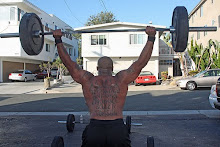
Human performance is something that is very near and dear to my heart. I can see through the eyes of a strength and conditioning coach as well as through the eyes of a head football coach. The balance for how best to prepare for battle on Fridays and Saturdays lies somewhere in between.
Training philosophy
You must be efficient in your training: From a coaching standpoint, you must be efficient at teaching so that you maintain your audience’s attention. From the athletes’ standpoint, you must be efficient because you’re balancing academics, time needed for developing sport-specific skills, and perhaps other sports. This doesn’t even include texting and messing with your iPod. You must be efficient in implementing whatever it is you want. Time is the only thing you and your opponent share. Who will use it most wisely?
What this means in regards to training is that you may want to implement many different movements when in reality you don’t have time to teach them or do them justice in the short time you have. This also includes following someone else’s routine. Being efficient is “performing or functioning in the best possible manner with the least waste of time and effort.” It isn’t “no pain no gain,” but “no brain no gain.”
If you can’t teach it, don’t implement it: There are literally thousands of exercises and movements that can be considered beneficial. You have to decide wisely what is best for you and your program. A perfect example is the Olympic lifts. Don’t stick them in your workout if you have no idea what triple extension is or how to perform these movements. I’m not saying that you have to be able to perform them at the highest level yourself when demonstrating. However, you do need to be able to communicate and understand why they’re in your program.
The coach wouldn’t install a screen play if he didn’t know how to draw the play on the board, verbally communicate it to players, evaluate it once executed, give feedback after running the play, implement it in practice, and call it during the game. Why should the insertion of a new exercise be any different?
Never stop learning: This applies to coaches and players. The first step to gaining knowledge is to realize you don’t have all the answers. With that said, let me be the first to admit that I don’t have all the answers, and I love the journey of continually searching for ways to do things better. Seek out experts in different areas, watch videos, read books, network with others, and always ask questions. With the progress of the internet, there is a resource for every component of training—nutrition, flexibility, conditioning, and so on.
There are many different yet effective ways to skin a cat: Before training, you must understand that there isn’t one single best way to train. You can get great results from a variety of methods and programs. During your training career, it will also be beneficial to utilize a variety of these to avoid physical and mental burnout. Don’t get caught up in what someone else or some other program is doing. You may not be prepared to engage in that type of training. You may not have the resources and or proper equipment.
Different athletes respond differently to training as well as to how they learn. When dealing with high school and college athletes, an incoming freshman is very different from a senior or fifth year student. As a result, both athletes will be at different points in their training age and will respond and require different types of training. As a coach and player, I’ve used three-day splits, four-day splits, Olympic lifts, speed equipment, no equipment, circuit training, linear periodization, and conjugate periodization. I’ve had results from all of them. Developing the best training plan is like a puzzle. Find where the pieces go.
Your peak will only be as high as the base: Athletes can play any sport because they possess abilities that can translate to all movements. Just like the fundamentals of blocking and tackling are necessary for success on the field, basic strength, flexibility, and speed mechanics are necessary for a player’s success. Sometimes too much time and energy is spent on fancy or “in vogue” things that an athlete isn’t ready for or doesn’t need.
Players need to be motivated: In a dream world, all players would be intrinsically motivated. Because this isn’t the case, we need to find a way to motivate the extrinsic type as well. For example, have T-shirts for award winners. I’m always amazed at how much T-shirts mean to players or what they will do to earn one. Try having 1000-lb Club T-shirts, Iron (mascot) T-shirts based off of the strength index (clean, squat, and bench divided by body weight), or 3 X 3 Club T-shirts for set gains on the three major lifts over an off-season or summer.
A record board is a must. It will get athletes competing with each other to have their names on it. Include videos of weight training and speed work on your team’s highlight video. Include pictures of award winners in your summer manual. Have daily competitions to teach athletes how to be seven-second competitors. Write personal notes encouraging players and recognize great effort in front of the team. Be creative in how you motivate. You could have the best program in the world on paper, but if the player isn’t motivated, it’s useless. Like the old saying goes, they don’t care how much you know until they know how much you care.









